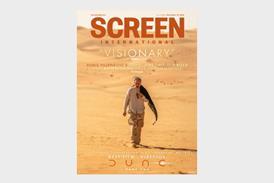IMAX started out as a niche in the exhibition business. Forty years on, the company has created its own distribution window. Now it just needs more screens. Denis Seguin reports.
When the Imax Corporation was founded 40 years ago at the Universal and International Exhibition (Expo 67) in Montreal, its creators were experimenting with multiple-projection systems to create a giant screen that would encompass the whole picture.
But while the screen was huge, its returns throughout most of the company's existence were piecemeal, built on incremental ticket sales akin to those generated by an amusement park ride. The typical Imax cinema was located in a museum or other cultural centre, and while some films shot in the format have earned big returns - The Dream Is Alive (1985) and Everest (1998) each earned more than $100m - the sums were realised over many years rather than through the high-volume turnover of the contemporary exhibition model.
Forty years later, Warner Bros' Harry Potter And The Order Of The Phoenix: The Imax Experience has broken nearly every Imax company record: the largest worldwide opening ($9.4m), the largest five-day domestic total ($7.3m), the largest week ($11.6m) and the largest single day ($1.9m).
It was also the widest-ever opening for Imax, with 91 screens in North America and 35 in the rest of the world; a further 17 screens are being added internationally. At time of going to press, the Imax version had grossed more than $27m worldwide.
This is just the latest title this year: Warner Bros' 300: The Imax Experience, released in March, and Sony's Spider-Man 3: The Imax Experience, released in May, have both grossed approximately $24m to date.
Breaking out
'We're no longer a niche business,' says Greg Foster, chairman and president of Imax Filmed Entertainment. 'When you're putting out $9.4m at the box office over five days, people pay attention. That's not a cute little cherry on top, that's serious money.'
For Richard Gelfond, co-CEO and co-chairman of Imax with Brad Wechsler, these numbers are the realisation of their ultimate goal when they took over the company in 1994. 'One of the main reasons we bought Imax is that we thought it could move into the mainstream entertainment landscape.'
But to grow the business beyond its educational roots, they had to increase both the number of Imax cinemas and the number of films available to play in them.
That aim was realised through two key technological advancements: the development of the DMR process, which digitally remasters conventional 35mm films into Imax's 15/70 format (the first film to get the DMR treatment was Ron Howard's Apollo 13) and the introduction by Imax of the MPX theatre system.
One of the barriers to entry was the expense of building an Imax-specific cinema; MPX allowed an exhibitor to retro-fit an existing cinema. 'Essentially, we made Imax plug-and-play,' says Gelfond.
It took one film to convince Hollywood to play along, according to Foster, crediting Robert Zemeckis' The Polar Express as the flag waver for the format's broader theatrical viability - it went on to make $65m at the box office on 84 prints.
Film-makers are now choosing Imax in increasing numbers. 'It used to be us going to them,' says Foster of Hollywood's interest in Imax. 'We've been in the DMR world for five years, we've generated $250m in box office, and now one of the things we take the most pride in is what we call our 'repeat customers'.'
He is referring to the likes of Zemeckis, who is readying a 3D Imax version of Beowulf to follow the conventional release in November, and Christopher Nolan who is shooting selected scenes from the upcoming The Dark Knight using Imax cameras (his Batman Begins was also shown in Imax).
A further two major 3D titles are due in cinemas in the summer of 2009: James Cameron's $200m Avatar, to be released through Twentieth Century Fox, and DreamWorks Animation's Monsters Vs Aliens.
Steven Spielberg and Peter Jackson are also exploring 3D for a trio of titles in the works based on Herge's Tintin books. DreamWorks Animation SKG president Jeffrey Katzenberg told The New York Times that all animated films will be presented in 3D from 2009.
However, the picture is not all perfect: the company's share price took a dive last year when Imax put itself up for sale and failed to attract a buyer. And it has been mired by concerns at both the US Securities and Exchange Commission and Canada's Ontario Securities Commission regarding the method it uses to record revenue from the sale of its cinema systems. Gelfond insists the company is close to putting the regulatory issues to rest.
On July 20, the company issued restated financial reports from 2002 through 2005 and reported a $16.9m loss for 2006. But the share price increased 10%, a clear vote of confidence from the investment community.
There are a couple of remaining hurdles: increasing the number of screens to capitalise on all this potential production, and making the move into digital projection. An Imax 2D print costs $23,000, a 3D presentation is double that: it uses two prints to create the stereoscopic effects. Digital projection would remove a significant expense. Imax has initiated joint ventures with exhibitors to cushion the cost of procuring the digital projector system. Beginning in July, exhibitors are travelling to Imax's Toronto-area research facility to see the system in action.
The Harry Potter release on 143 Imax screens is a limited release, comparatively speaking. If Imax were to increase that number by 50% without the expense of prints, it is easy to see how the big screen could keep on growing.
| TOP 5 IMAX ORIGINAL PRODUCTIONS (W'WIDE) | |
| 1 The Dream Is Alive | $150m |
| 2 T-Rex | $98m |
| 3 Space Station | $95m |
| 4 Blue Planet | $73m |
| 5 Into The Deep | $71m |
TOP 5 HOLLYWOOD RELEASES CONVERTED TO IMAX (W'WIDE) | |
| 1 The Polar Express | $65m |
| 2 Superman Returns | $31m |
| 3 300 | $24m |
| 4 Spider-Man 3 | $24m |
| 5 Harry Potter And The Order Of The Phoenix* | $23m |
*(to date) | |



















No comments yet